Dynasty XIX, c. 1275-1225 BCE

|
Nubian CaptivesOn the base of the chairs on each side of the entrance are reliefs representing captured prisoners: Nubian prisoners to the south and Asians to the north. |
| |
|
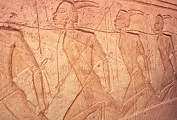
|
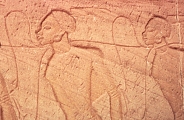
|
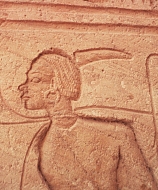 |
| |
|
Asian Captives |
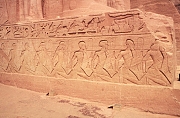
|

|
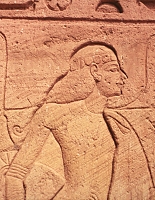 |
| |
|
Left: The cartouches at the base represent Ramses's name. Center and right: Hapi, the Nile-god is represented binding together the symbols of Upper and Lower Egypt--the papyrus and lotus
|

|
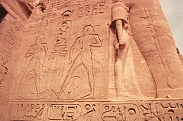
|
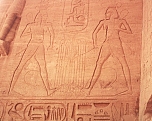 |
| |
|
The InteriorThe temple interior is cut 61 meters into the mountain. The rectangular pronaos is 18 meters long and more than 16 meters wide. |
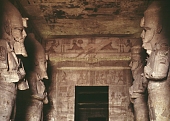
|
Eight Osiris pillars (10 meters high) with the features of Ramses have arms crossed, holding a scepter and flail. They are arranged in two rows, those on the left wearing the white crown of Upper Egypt, those on the right with the double crown. The great vulture goddess is painted on the ceiling. |
| |
|
Details of the Osiride statues |
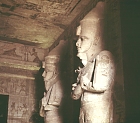
|

|
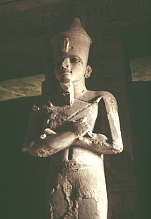
|
| |
|
Wall decoration depicts military victories of Ramses II. (Photographed by William J. Sullivan, my husband.)
Behind the pronaos are first a small hypostyle hall, then a vestibule, and finally at the rear a small sanctuary. It is oriented so that twice a year the sun shines directly into the sacred space where there are statues of the gods to whom the temple is dedicated. |

|


 Click here to return to page 1.
Click here to return to page 1.
 Click here to go to the Egypt Index.
Click here to go to the Egypt Index. Click here to return to index of art historical sites.
Click here to return to index of art historical sites.
 Click here to return to index of artists and architects.
Click here to return to index of artists and architects.
 Click here to return to chronological index.
Click here to return to chronological index.
